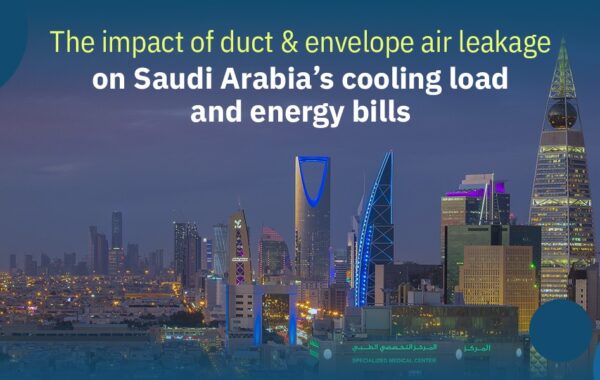
ASHRAE’s Latest Duct Leakage Standards: What They Mean for You
Introduction
Energy efficiency and indoor air quality have become top priorities in the construction and HVAC industry. For contractors in Saudi Arabia, this focus is even more critical. With commercial buildings like hospitals, universities, and corporate towers consuming vast amounts of cooling energy, even small inefficiencies in HVAC systems can drive up operational costs. One of the most overlooked inefficiencies is duct leakage.
ASHRAE (the American Society of Heating, Refrigerating, and Air-Conditioning Engineers) has released updated duct leakage standards that are reshaping how projects are designed, tested, and delivered. For contractors and building operators in Saudi Arabia, these standards are not just technical guidelines they are a roadmap to compliance, efficiency, and better performance.
This article explains what the latest ASHRAE duct leakage standards mean for you, why they matter in the Saudi market, and how to prepare for compliance.
Understanding the Role of ASHRAE Standards
ASHRAE is the global authority that sets the benchmarks for HVAC system design, installation, and performance. Its duct leakage standards are critical because duct systems are responsible for distributing conditioned air throughout buildings.
When ducts leak, buildings lose efficiency, occupants experience uneven temperatures, and energy bills increase. In Saudi Arabia, where cooling is a year-round necessity and accounts for up to 70% of energy use in some buildings, the impact of duct leakage is magnified.
The latest ASHRAE updates bring duct leakage requirements in line with today’s sustainability goals and advanced testing methods, ensuring that commercial buildings operate at their highest potential.
Key Updates in ASHRAE’s Duct Leakage Standards
The new standards address several areas that contractors must pay attention to during design, installation, and commissioning.
1. Tighter Leakage Classifications
ASHRAE now requires stricter leakage class ratings, reducing the allowable air loss per square meter of duct surface area. This means that ducts in Saudi commercial buildings must be designed and sealed more precisely.
2. Expanded Testing Protocols
Contractors will see more rigorous requirements for duct leakage testing. Testing at different pressure levels and for various duct types — round, oval, and rectangular — is now clearly defined.
3. Integration with Building Codes
The latest standards align closely with energy codes that many regions, including Saudi Arabia under the Saudi Building Code (SBC), are adopting. This makes compliance not only best practice but also mandatory for certain projects.
4. Emphasis on Aerosolized and Spray Sealants
ASHRAE recognizes advanced sealing technologies such as aerosolized duct sealing. These solutions provide a more effective and measurable way to reduce leakage in complex duct networks, particularly in large commercial buildings.
Why These Updates Matter for Saudi Arabia
The Saudi construction sector is undergoing rapid transformation as part of Vision 2030, with emphasis on sustainable, energy-efficient infrastructure. Commercial projects like medical complexes, universities, and office towers are expected to meet higher performance benchmarks.
High Cooling Demand
Saudi Arabia’s extreme climate means that any inefficiency in air distribution directly translates into higher energy use and operational costs. Meeting ASHRAE’s updated standards can significantly reduce wasted cooling capacity.
Regulatory Alignment
The Saudi Building Code is increasingly referencing international best practices, including ASHRAE standards. Contractors who align their practices with these updates will be better positioned to win bids and deliver compliant projects.
Competitive Advantage
Clients in Saudi Arabia are becoming more conscious of energy efficiency and sustainability. Contractors who demonstrate compliance with the latest duct leakage standards can stand out in competitive tenders, especially for government, healthcare, and education projects.
What Contractors Need to Do Now
1. Review Your Design and Installation Practices
Design teams must revisit duct system layouts to minimize leakage potential. Installers need training on the updated sealing techniques and materials recognized by ASHRAE.
2. Invest in Advanced Testing
Accurate duct leakage testing is no longer optional. Contractors should adopt state-of-the-art testing equipment to comply with the updated standards and provide clients with verifiable results.
3. Adopt Modern Sealing Technologies
Traditional sealing methods like tape and mastic have limitations, especially in large commercial buildings. Advanced solutions such as Aeroseal technology can seal leaks from the inside, ensuring compliance and reducing the time required for manual sealing.
4. Document Everything
ASHRAE’s latest standards emphasize documentation for compliance. Contractors must provide detailed reports on duct testing, sealing methods, and leakage rates. This not only ensures compliance but also builds trust with clients.
Impact on Building Owners and Operators
While these standards may initially seem like added complexity, they bring long-term benefits for owners and operators of Saudi commercial buildings.
- Lower Energy Bills: Reduced leakage means HVAC systems operate more efficiently, lowering energy consumption.
- Improved Indoor Air Quality: Properly sealed ducts prevent dust, pollutants, and unconditioned air from entering the system.
- Better Comfort: Occupants experience consistent temperatures across offices, classrooms, and hospital wards.
- Longer Equipment Life: With less strain on HVAC systems, equipment operates under optimal conditions, reducing maintenance costs.
Practical Steps for Staying Ahead
- Educate Your Teams – Train engineers, site supervisors, and technicians on ASHRAE’s updated requirements.
- Upgrade Your Equipment – Invest in leakage testing tools and sealing technologies to stay compliant.
- Collaborate Early – Engage with consultants and building owners early in the design phase to plan for compliance.
- Highlight Compliance in Bids – Show clients how your projects meet ASHRAE standards. This strengthens your value proposition and increases trust.
Conclusion
ASHRAE’s latest duct leakage standards mark a turning point for HVAC contractors and building operators in Saudi Arabia. They are not just technical requirements — they represent a pathway to higher efficiency, lower costs, and sustainable building performance.
Contractors who adapt quickly, invest in modern technologies, and align their projects with these standards will gain a strong competitive edge in the Saudi commercial construction market.
By embracing these updates, you are not only meeting compliance but also delivering better buildings for the future of Saudi Arabia.



